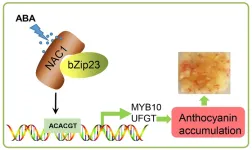(Press-News.org) Over the past few decades, it has become obvious that climate change, and consequent extreme weather events, can wreak havoc on crop yields. Concerningly, there is a large disparity in agricultural vulnerability between developed and developing countries. In a new study, researchers have looked at major food grains in India to understand the long- and short-term effects of climate change on crop yields.
“Most studies that measure the effects of climate change are looking at year-to-year changes, which are representative of variations in weather and not climate,” said Madhu Khanna (CABBI), a professor of agriculture and consumer economics. “We used data across 60 years to examine how deviations in weather from long-term averages affect the yields of three major cereal crops: rice, maize, and wheat.”
Changes in weather are short term, like a hot day with a sudden thunderstorm. However, such variations may be distinct from long-term differences, which are the hallmark of climate change. “We were looking to see if the effect of short-term deviations in extreme temperature and precipitation are significant when compared to their long-term averages and if their effects are absent in the long term as farmers adapt to climate change,” Khanna said.
The researchers used quantile regression models to determine if farmers were adapting to the long-term changes in climate. To do so, they used 60-year data sets on temperature, precipitation, the length of the growing season, and crop yield to create different models for short-term and long-term responses of crops.
According to their analysis, if differences in temperature, for example, have no impact in either model, there have been no adaptations. On the other hand, if the short-term impact is worse, it means that the farmers have been able to adapt and smooth out the effects.
“We found that the farmers were able to adapt to changes in temperature for rice and maize but not wheat. Increased precipitation enhanced rice yield, but adversely affected wheat and maize yields,” Khanna said. “We also found that farmers are customizing their strategies across different regions and crops. For example, heat-prone districts fared better to higher temperatures compared to districts in colder regions.”
“The impacts are higher at the lower tail of the distribution, but are lower at the upper tail of the distribution,” said Surender Kumar, a professor of economics at the University of Delhi, India. Farmers who worked in areas that were less productive, and therefore at the lower tail of distribution, differed in their response to those who worked in areas where the yields were higher—the former took more adaptation measures due to higher impacts.
“Higher productive regions have better irrigation facilities and are less dependent on the monsoon, and so the difference between long-term and short-term impacts is negligible,” Kumar said.
There are two ways by which the crops can adapt: the farmers can change their management practices or the varieties themselves are hardier. Although this study cannot distinguish between these possibilities, it suggests that action can be taken to improve seed varieties and educate farmers on how they can adapt to changing climate.
“This study is a part of our overall effort to build understanding across different countries. In the past we did a similar study in the US and now we're doing it for India. It's interesting that the results of this study are telling us that in both countries, although there is a negative impact of climate, the crops are adapting,” Khanna said. “However, these effects differ across crops and across the type of effects they are adapting to. We need to take a holistic view of all the various ways in which changing climate effects yield, which is obviously a very challenging and complex problem, and understand that focusing on particular dimensions of climate change and adapting crops may not be sufficient.”
The study “Distributional heterogeneity in climate change impacts and adaptation: Evidence from Indian agriculture” was published in Agricultural Economics and can be found at https://doi.org/10.1111/agec.12765.
END
Understanding the long-term impact of climate change on Indian crops
2023-04-24
ELSE PRESS RELEASES FROM THIS DATE:
New machine learning framework for more accurate plant disease diagnosis
2023-04-24
Plant diseases pose a significant threat to nations across the globe, owing to the financial burden they impose and the impact they have on food security. Healthy crops sustain millions of livelihoods, and accurate diagnosis of plant diseases allows for timely interventions to ensure sufficient crop production with minimal yield loss. Traditional approaches to disease recognition typically follow two paths. The first relies on crop inspection by trained experts, while the second leverages neural networks ...
Differentiation landscape of acute myeloid leukemia charted with new tool
2023-04-24
Researchers have developed a new method to distinguish between cancerous and healthy stem cells and progenitor cells from samples of patients with acute myeloid leukaemia (AML), a disease driven by malignant blood stem cells that have historically been difficult to identify. The findings, published today in the journal Cell Stem Cell, pave the way for the development of new techniques to predict whether patients will respond to chemotherapy.
AML is a type of cancer characterised by the rapid growth and accumulation of abnormal white blood cells. ...
Sanghera receives funding for pilot project
2023-04-24
Kamaljeet Sanghera, Executive Director, Institute for Digital InnovAtion (IDIA), Research and Innovation Initiatives; Professor, Information Sciences and Technology, received funding to design and deliver a pilot of a summer, hands-on experience for 20 high school students.
Sanghera will leverage IBM artificial intelligence (AI) kits to help the students gain technical skills, knowledge, and abilities in AI and an understanding of its ethical and social impact.
Sanghera received $150,000 from Trenchant Analytics, LLC, on a subaward from the ...
JMIR Publications and Society of Digital Psychiatry partner to advance digital mental health research
2023-04-24
(Toronto, April 24, 2023) JMIR Publications and the Society of Digital Psychiatry (SODP) have announced a new partnership aimed at advancing research in the field of digital mental health. This collaboration will focus on supporting education and knowledge sharing in the fast moving world of digital psychiatry and establishing priorities for the space, including identifying current gaps in knowledge and determining areas for future study, with particular emphasis on addressing disparities in access to care.
The partnership brings together JMIR Publications, a leading open-access publisher of scholarly journals on digital health, ...
The ABA-induced NAC transcription factor MdNAC1 interacts with a bZIP-type transcription factor to promote anthocyanin synthesis in red-fleshed apples
2023-04-24
Exploring the upstream transcription factors or proteins interacting with MdMYB10 is an important way to enrich the complex network of anthocyanin synthesis. In this study, the upstream regulatory gene MdNAC1 of MdMYB10 was selected through yeast one hybridization experiments, and EMSA and LUC experiments showed that MdNAC1 can transcriptionally activate MdMYB10. The transformation experiments in apple callus and apple fruit showed that MdNAC1 significantly promoted the accumulation of anthocyanins. At the same time, researchers have found that MdNAC1 can interact with MdbZIP23 ...
Problems with ‘pruning’ brain connections linked to adolescent mental health disorders
2023-04-24
Problems with the brain’s ability to ‘prune’ itself of unnecessary connections may underlie a wide range of mental health disorders that begin during adolescence, according to research published today.
The findings, from an international collaboration, led by researchers in the UK, China and Germany, may help explain why people are often affected by more than one mental health disorder, and may in future help identify those at greatest risk.
One in seven adolescents (aged 10-19 years old) worldwide experiences mental health disorders, according to the World Health Organization (WHO). Depression, anxiety and behavioural disorders, such as ...
Neutralizing monoclonal antibody use and COVID-19 infection outcomes
2023-04-24
About The Study: In this study that included 167,000 non-hospitalized patients, neutralizing monoclonal antibody (nMAb) treatment for COVID-19 was safe and associated with reductions in emergency department visits, hospitalization, and death, although it was not associated with reduced risk of hospitalization during the Omicron BA.1 epoch. These findings suggest that targeted risk stratification strategies may help optimize future nMAb treatment decisions.
Authors: Brian Anderson, M.D., of the MITRE Corporation in Bedford, Massachusetts, is the corresponding author.
To access the embargoed study: Visit our For The Media website ...
New insights on the risk for atrial fibrillation in children and young adults
2023-04-24
Researchers at Karolinska Institutet in Sweden have investigated how preterm birth and foetal growth are related to the risk of atrial fibrillation up to middle-age. The study, which is published in JAMA Pediatrics, shows that being born preterm or large for gestational age was associated with increased risks of atrial fibrillation later in life. Being small for gestational age at birth was only associated with an increased risk of atrial fibrillation up to the age of 18.
The incidence of atrial fibrillation in the young has increased over the past few decades, from low levels.
“Atrial fibrillation at a young age may involve a heavy socioeconomic burden for the affected ...
Vaccine printer could help vaccines reach more people
2023-04-24
CAMBRIDGE, MA -- Getting vaccines to people who need them isn’t always easy. Many vaccines require cold storage, making it difficult to ship them to remote areas that don’t have the necessary infrastructure.
MIT researchers have come up with a possible solution to this problem: a mobile vaccine printer that could be scaled up to produce hundreds of vaccine doses in a day. This kind of printer, which can fit on a tabletop, could be deployed anywhere vaccines are needed, the researchers say.
“We could someday ...
Scientists have full state of a quantum liquid down cold
2023-04-24
A team of physicists has illuminated certain properties of quantum systems by observing how their fluctuations spread over time. The research offers an intricate understanding of a complex phenomenon that is foundational to quantum computing—a method that can perform certain calculations significantly more efficiently than conventional computing.
“In an era of quantum computing it’s vital to generate a precise characterization of the systems we are building,” explains Dries Sels, an assistant ...








